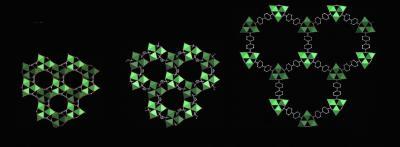Previously, only amorphous polymer materials approached such levels of performance. On the other hand, these “gigantic respiration” and their respiration, which takes place at constant overall shape, is reversible. This discovery, of interest for numerous industrial applications, is published in the journal Science on March 30, 2007. Structure of chromium (III) diphenyl dicarboxylate, one of the gigantic respiration crystalline solids, in its crude form following synthesis (middle), with all traces of solvent removed (on the left), and after absorption of solvent and increase in volume (on the right).
Structure of chromium (III) diphenyl dicarboxylate, one of the gigantic respiration crystalline solids, in its crude form following synthesis (middle), with all traces of solvent removed (on the left), and after absorption of solvent and increase in volume (on the right).
Credit: G. Ferey - CNRS 2007
The phenomenon of respiration is normally associated with life. It is characterized by a reversible variation in the volume of a species under the effect of a stimulus (gas, pressure, temperature, irradiation, etc.). The volume of the lungs, for example, expands by 40 percent when breathing in. Organic matter, known for its flexibility, is well suited to this phenomenon. On the other hand, inorganic matter is very often associated with the idea of rigidity and non-deformability. Researchers from the Institut Lavoisier (CNRS/Université de Versailles Saint-Quentin-en-Yvelines) have recently demonstrated that the hybrid material (which combines both inorganic and organic entities) can be deformed in a reversible manner.
Within the framework of their studies on porous systems, Gérard Férey and his team at the Institut Lavoisier have discovered a new family of trivalent metal dicarboxylates, which possess unprecedented respiration properties. Depending on the nature of the organic entity, the variation in volume when these solids are immersed in a solvent (water, methanol, etc.) can exceed 300 percent. Only some amorphous polymers approach this level of performance. However, unlike such polymers, the new solids are crystalline. The researchers determined their crystallographic structure in each state (solvated or not) and provided an explanation for the respiration mechanism, which takes place at constant overall shape, without any apparent rupture of bonds at the atomic level. The reversibility of the phenomenon is therefore facilitated.
A laboratory curiosity? Certainly not: given the selectivity of its adsorption of solvents, this new family of solids has already been used in separation applications. Another flexible solid stemming from the laboratory has also been produced on an industrial scale for its hydrogen storage properties.
Written from a news release by CNRS.